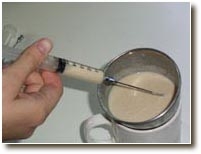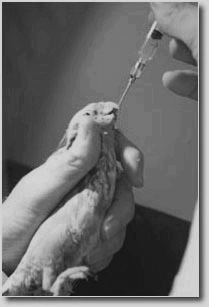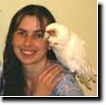![]()
Emergency Treatment Using ER Formula
Most orphaned wild birds and aviary birds that stop eating because of illness can be saved when ER formula is given. ER stands for “EMERGENCY RESCUE”. ER Formula is best administered using a crop needle, but it can also be given by spoon or syringe. It is ideal for orphaned nestlings who accept it voraciously by the syringe or spoon method. The crop needle application is a special technique that requires a crop needle and individual tuition.
The following procedures stabilize the body functions whilst the exact nature of the disease is ascertained for ill aviary birds, or allows orphaned birds to recover from their ordeal:
- Heated ER Formula is administered by a crop needle.
- Provide bird with radiated or electric heating.
- Provide clean seed and water.
- Remove sand and grit.
Immediate heat and energy supplements are needed to save seriously ill birds.
The ill bird loses body heat very quickly when it stops eating, as the energy reserves are depleted by illness. By re-establishing the normal body temperature and blood sugar levels, most lives are saved. Heat of 35 degrees Celsius ( 90 degrees F ) is needed since the normal body temperature of most birds is 42 degrees Celsius.
The internal body core temperature is most quickly elevated by a heated energy source (ER formula) administered directly into the crop. For example, 3mls of ER Formula of maple syrup consistency and heated to 35 degrees Celsius is given to budgerigar-sized birds using an 18 gauge crop needle. The bird is then placed into a quiet, heated hospital cage. Clean paper is used on the floor to monitor and collect droppings. Fresh food and water is given, but grit, sand and other foods are removed until recovery is complete because the ill bird often over-engorges on grit and then obstructs the gizzard causing death.
Utensils for Crop Feeding
A syringe and crop needle should be used for crop feeding. In between feeds, boil the utensils, etc., so as to prevent any food spoilage and subsequent infections. The utensils are soaked in KD Water Cleanser after cleaning. The ER Formula must be made fresh and the leftovers discarded.
Amounts and methods for feeding ER Formula
The size of crop needle and amount of ER Formula are as follows:
|
Preparing the ER Formula Have everything ready before preparing the ER Formula. You will need hot water, a medium-sized bowl, 2 small cups, a butter knife or spoon, a 3ml syringe and crop needle with which to feed the bird and a small towel to wipe the bird's face clean. Prepare the formula by following these steps. This recipe makes 3mls of ER Formula. Adjust the amount accordingly for larger sized birds.
Have everything ready before preparing the ER Formula. You will need hot water, a medium-sized bowl, 2 small cups, a butter knife or spoon, a 3ml syringe and crop needle with which to feed the bird and a small towel to wipe the bird's face clean. Prepare the formula by following these steps. This recipe makes 3mls of ER Formula. Adjust the amount accordingly for larger sized birds.
- 1. Fill the medium-sized bowl with hot water.
- 2. Into the small cup, add 1 spoonful of ER Formula.
- 3. Hold the small cup in the larger bowl so that the hot water keeps the formula warm.
- 4. Adding a couple drops of hot water from the tap at a time, use the butter knife or back of the spoon to mix the powder into a paste.
- 5. Use the knife or spoon to squash the formula against the side of the cup to smooth out all lumps.
- 6. Continue adding a couple drops of hot water at a time until the formula is the consistency of maple syrup.
- 7. Have the bird nearby, but not in the preparation area, as the water and ER Formula must remain hot when fed to your sick bird.
- 8. It is best not to make the formula in the microwave. Mix by hand with the hot water and double check the temperature before feeding.
- 9. Continue feeding for one day after the bird is seen eating seed on its own.
Spilled food around the bird's face should be cleaned with a warmed cleaned cloth before it dries. A “bib” may help keep the feathers clean, as well as a fine warm water mist spray over the body when weather is hot, but prevent chilling.
The Crop Needle Technique
Some tips when crop needling birds (The crop needle is a blunt needle or crop tube passed gently and directly into the crop.):
  |
|
-
- 1. Always lubricate the crop needle prior to use. A small amount of spit, oil or Vaseline helps the tube to slide into the fragile and often dry esophagus.
- 2. Make the ER Formula very warm and fresh each meal. Pre-warm the syringe and needle. Use hot water and not a microwave to heat the formula, as this avoids “hot spots” that burn the crop lining.
- 3. Clean and disinfect the crop needle and feeding syringe with the KD Water Cleanser after every feeding.
- 4. Extend the neck as the needle is slowly introduced from the right side of the beak into the left side of the back of the mouth. The crop needle is then passed gently into the crop. Check it is in the crop by feeling for the crop needle through the skin on the outside of the crop. Now slowly inject the formula into the crop.
- 5. Fill the crop with the formula. Stop when the tongue moves in a swallowing motion and then quickly but gently remove the needle. Medication may also be mixed into the ER Formula.
- 6. Immediately return the bird to the heated hospital cage.
Alternative products To ER Formula
-
- Glucodin 5% (glucose powder) and hot water.
- Honey 5% and hot water.
- Polenta (corn powder) or rice flour and hot water.
- Strained baby food.
Notes:
This formula is used for seed-eating birds and not for Lorikeets. Lorikeets are best fed grapes, apple puree or apricot juice by spoon, rather than by a crop needle.
Copyright © 2002 Rob Marshall, All Rights Reserved.





